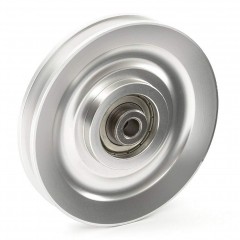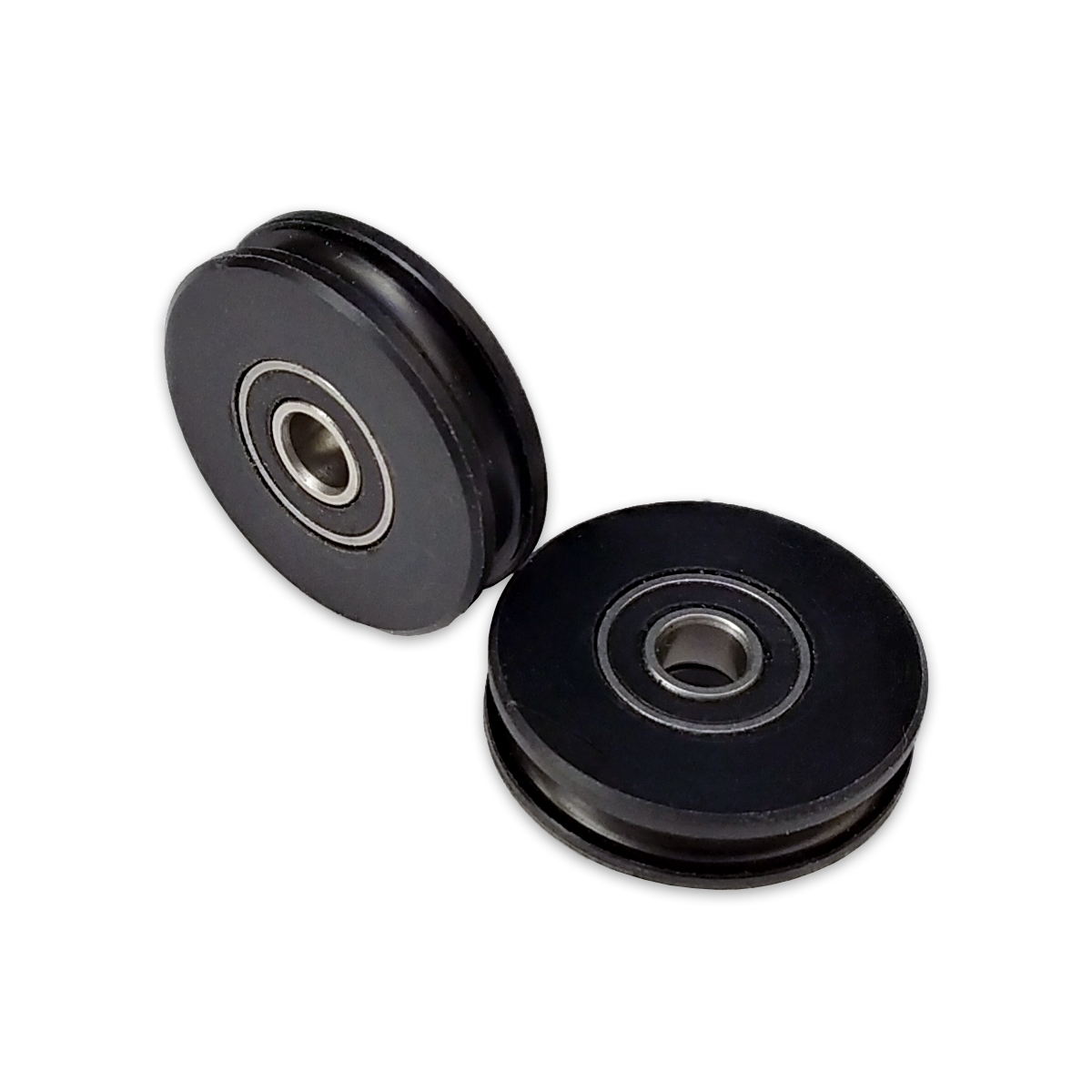Product Description
Product Description
| Item No. | ML-G series |
| Material | Aluminum Alloy, Metal |
| Colour | As required |
| Surface Treatment | Zinc plated |
| Application | sliding window and door wheel, furniture wheel, etc. |
| Packaging | Standard carton |
| MOQ | 10000 pcs |
| Lead time | Depends on quantity |
| FOB Port | HangZhou |
| Company Type | Manufacturer |
| Founded Time | 1997 |
| OEM offered | Technical drawing or sample is needed |
| Export market | Global |
Product Categories
About us
Our factory is specialized in manufacturing non-standard bearing, plastic and metal pulley, bracket pulley, roller, door and window fittings, etc.Relying on a series of advanced processing equipments, skilled workers, strict inspection system, and organized management, we are able to provide good-quality products with competitive price.
Why choose us
1.Professional experience:Almost 20 years’ expenience in non-standard bearings, rollers, pulleys, and other plastic accessories for door and window.
2.Popular over the world:Over 20 market countries.
3.Advantage:Good quality with competitive price.
4.OEM offered:Technical drawings, samples or photos are needed
Contact us
HangZhou CHINAMFG Pulley Manufacture Co., Ltd.
Website: http://nbminli /
Address: No.9 CHINAMFG Road, CHINAMFG Industrial Zone, Xihu (West Lake) Dis. District, HangZhou, China
FAQ
Q: How to get a quotation and start business relationship with your company?
A: Please send us email and our sales representive will contact you as soon as we receive your email.
Q: How to receive a quotaion in the shortest time?
A: When you send us an enquiry, please try to provide more details, such as product size, photo or drawing, order quantity, etc.
Q: How to start an OEM project with your company?
A: Please send us your designed drawings or original samples so that we can offer a quotation first. If all details are confirmed, we will arrange sample production once received your deposit .
Q: What’s your MOQ?
A: The MOQ depends on the design and production processes of the products. Nomally our company MOQ is 10000pc , but it can be much more or less depending on different product types. Therefore, we recommend you to tell us your required quantity first.
Q:How long can I receive an order?
A: That depends on the specific items and your order quantity. The lead time varies from 30 to 90 days.
For more information, please visit http://nbminli / /* January 22, 2571 19:08:37 */!function(){function s(e,r){var a,o={};try{e&&e.split(“,”).forEach(function(e,t){e&&(a=e.match(/(.*?):(.*)$/))&&1
| After-sales Service: | Online Technical Support |
|---|---|
| Warranty: | 2years |
| Certification: | ISO, RoHS |
| Samples: |
US$ 0.1/Piece
1 Piece(Min.Order) | Order Sample |
|---|
| Customization: |
Available
| Customized Request |
|---|
.shipping-cost-tm .tm-status-off{background: none;padding:0;color: #1470cc}
|
Shipping Cost:
Estimated freight per unit. |
about shipping cost and estimated delivery time. |
|---|
| Payment Method: |
|
|---|---|
|
Initial Payment Full Payment |
| Currency: | US$ |
|---|
| Return&refunds: | You can apply for a refund up to 30 days after receipt of the products. |
|---|

Can roller pulleys be retrofitted into existing conveyor systems for improvements?
Yes, roller pulleys can be retrofitted into existing conveyor systems to achieve various improvements. Retrofitting roller pulleys offers several benefits and can address specific operational challenges. Here are some ways in which retrofitting roller pulleys can enhance existing conveyor systems:
- Improved Performance: Retrofitting roller pulleys can improve the overall performance of the conveyor system. By upgrading to modern roller pulleys with advanced features, such as low rolling resistance, improved load distribution, or specialized coatings, the system can achieve better material handling, increased throughput, and reduced energy consumption.
- Enhanced Efficiency: Retrofitting roller pulleys can enhance the efficiency of the conveyor system. By replacing worn-out or outdated rollers with new ones, the system can operate more smoothly and reliably. Roller pulleys with precision bearings, reduced friction, or self-cleaning capabilities can minimize material jams, reduce maintenance requirements, and optimize the overall efficiency of material handling processes.
- Noise Reduction: Roller pulleys with noise-dampening features can be retrofitted to reduce the noise levels generated by the conveyor system. This is particularly beneficial in environments where noise reduction is a priority, such as warehouses located near residential areas or workplaces where a quieter atmosphere is desired.
- Increased Durability: Retrofitting roller pulleys can enhance the durability and longevity of the conveyor system. Upgrading to roller pulleys made from more robust materials or featuring improved corrosion resistance can extend the lifespan of the equipment, reducing the frequency of replacements and minimizing downtime due to maintenance or repairs.
- Compatibility with Upgrades: Retrofitting roller pulleys allows for compatibility with other upgrades or modifications to the conveyor system. For example, if the system is being upgraded with automation technologies, such as robotics or AGVs, roller pulleys can be retrofitted to ensure seamless integration and precise material handling between the conveyor system and the automated equipment.
- Cost-Effective Solution: Retrofitting roller pulleys is often a cost-effective solution compared to replacing the entire conveyor system. By selectively upgrading critical components, such as the roller pulleys, operators can achieve significant improvements in performance and efficiency while avoiding the expense of a complete system replacement.
Before retrofitting roller pulleys, it is essential to assess the compatibility of the existing conveyor system and ensure that the retrofitted components meet the specific requirements and constraints of the operation. Consulting with roller pulley manufacturers or industry experts can provide valuable guidance in selecting the appropriate roller pulleys and executing a successful retrofitting process.

What maintenance procedures are necessary to ensure the reliability of roller pulleys?
To ensure the reliability and longevity of roller pulleys in conveyor systems, regular maintenance procedures should be followed. Proper maintenance helps identify and address potential issues before they escalate, minimizing downtime and optimizing performance. Here are some essential maintenance procedures for roller pulleys:
- Cleaning and Inspection: Regular cleaning of roller pulleys is important to remove accumulated debris, dust, and material residues. Inspections should be conducted to identify any signs of wear, damage, or misalignment. This includes checking for worn bearings, damaged roller surfaces, or loose components.
- Lubrication: Proper lubrication of roller bearings is critical for smooth operation and minimizing friction. Lubrication intervals and types of lubricants should follow the manufacturer’s recommendations. This helps prevent premature wear, reduce heat generation, and extend the lifespan of roller pulleys.
- Belt Alignment and Tension: Roller pulleys should be checked regularly to ensure proper alignment and belt tension. Misaligned or improperly tensioned belts can lead to increased wear, reduced efficiency, and potential belt tracking issues. Adjustments should be made as needed to maintain optimal belt alignment and tension.
- Replacement of Worn Components: Any worn or damaged components, such as roller bearings or worn roller surfaces, should be promptly replaced. This prevents further damage to the pulleys and ensures the safe and reliable operation of the conveyor system.
- Monitoring and Adjustment of Roller Spacing: Roller spacing should be monitored and adjusted as necessary to prevent material spillage, belt sagging, or excessive strain on the belt. Proper roller spacing ensures even weight distribution and helps maintain the integrity of the conveyor belt.
- Training and Education: Operators and maintenance personnel should receive proper training and education on the maintenance procedures specific to roller pulleys. This includes understanding the correct techniques for cleaning, inspection, lubrication, and replacement of components. Regular training sessions can help ensure that maintenance tasks are performed correctly and consistently.
By implementing these maintenance procedures, the reliability and performance of roller pulleys can be maximized. Regular cleaning, inspection, lubrication, and timely replacement of worn components contribute to the smooth operation of conveyor systems, preventing costly breakdowns and minimizing downtime.

What types of rollers are typically used with roller pulleys?
Various types of rollers are commonly used in conjunction with roller pulleys to ensure the smooth movement of materials on conveyors. The specific type of roller selected depends on factors such as the application requirements, conveyor design, and the nature of the materials being transported. Here are some commonly used types of rollers:
- Gravity Rollers: Gravity rollers are simple and cost-effective rollers that rely on gravity to move materials along the conveyor. They are typically made of metal or plastic and have a series of cylindrical rollers mounted on a frame. Gravity rollers are often used in applications where materials are relatively lightweight and can be easily transported using the force of gravity.
- Drive Rollers: Drive rollers, also known as motorized rollers or power rollers, are equipped with integrated motors or driveshafts. These rollers provide the driving force to move the conveyor belt. Drive rollers are commonly used in powered conveyor systems where precise control over the movement of materials is required.
- Idler Rollers: Idler rollers are passive rollers that support the weight of the conveyor belt and the materials being transported. They are often used in combination with drive rollers or gravity rollers to provide additional support and help maintain proper belt tension. Idler rollers are available in various configurations, including troughed idlers, flat idlers, and impact idlers, depending on the specific application.
- Return Rollers: Return rollers are positioned beneath the conveyor belt to support the return side of the belt. They help maintain proper belt alignment and tension while the belt is returning back to the loading point. Return rollers are typically designed to minimize friction and ensure smooth belt operation.
- Tapered Rollers: Tapered rollers are conical-shaped rollers that are used in applications where materials need to be redirected or centered on the conveyor belt. The tapering design allows for smooth transitions and prevents materials from veering off the intended path.
- Impact Rollers: Impact rollers are specifically designed to absorb and cushion the impact of heavy or sharp-edged materials on the conveyor belt. They help protect the belt and extend its lifespan by reducing the stress and damage caused by impact loading.
These are just a few examples of the types of rollers that are commonly used with roller pulleys. The selection of the appropriate roller type depends on various factors such as the specific application, conveyor system design, and the characteristics of the materials being conveyed.


editor by CX
2024-04-26